Applying and Evaluating the Modified Method of the Rothermel Model under No-Wind Conditions for Pinus koraiensis Plantations
Abstract
:1. Introduction
2. Materials and Methods
2.1. Indoor-Simulated Fire-Spread Experiment
2.1.1. Fuel-Bed Preparation
2.1.2. Slope Preparation
2.1.3. Measurement of the Fire-Spread Rate
2.2. Data Analysis
2.2.1. Rothermel Model
2.2.2. Modification Method of Priority to No-Wind or Slope Conditions
2.2.3. Modification Method of Priority to Slope Conditions
2.2.4. Analysis of Variance (ANOVA) and Correlation
2.2.5. Model Evaluation
3. Results
3.1. Statistics of the Fire-Spread Rate and Influencing Factors
3.2. Prediction Accuracy of the Rothermel Model for Fire-Spread Rate Predictions
3.3. No-Wind or Slope Conditions Priority Modified Rothermel Model
3.4. Slope Condition Priority Modified Rothermel Model
3.5. Comparing the Prediction Errors for the Three Models
4. Discussion
4.1. Factors Influencing the Fire-Spread Rate
4.2. Application of the Rothermel Model
4.3. Modifications of the Rothermel Model
4.4. Application of Fire-Spread Rate Prediction
5. Conclusions
Author Contributions
Funding
Data Availability Statement
Conflicts of Interest
Appendix A

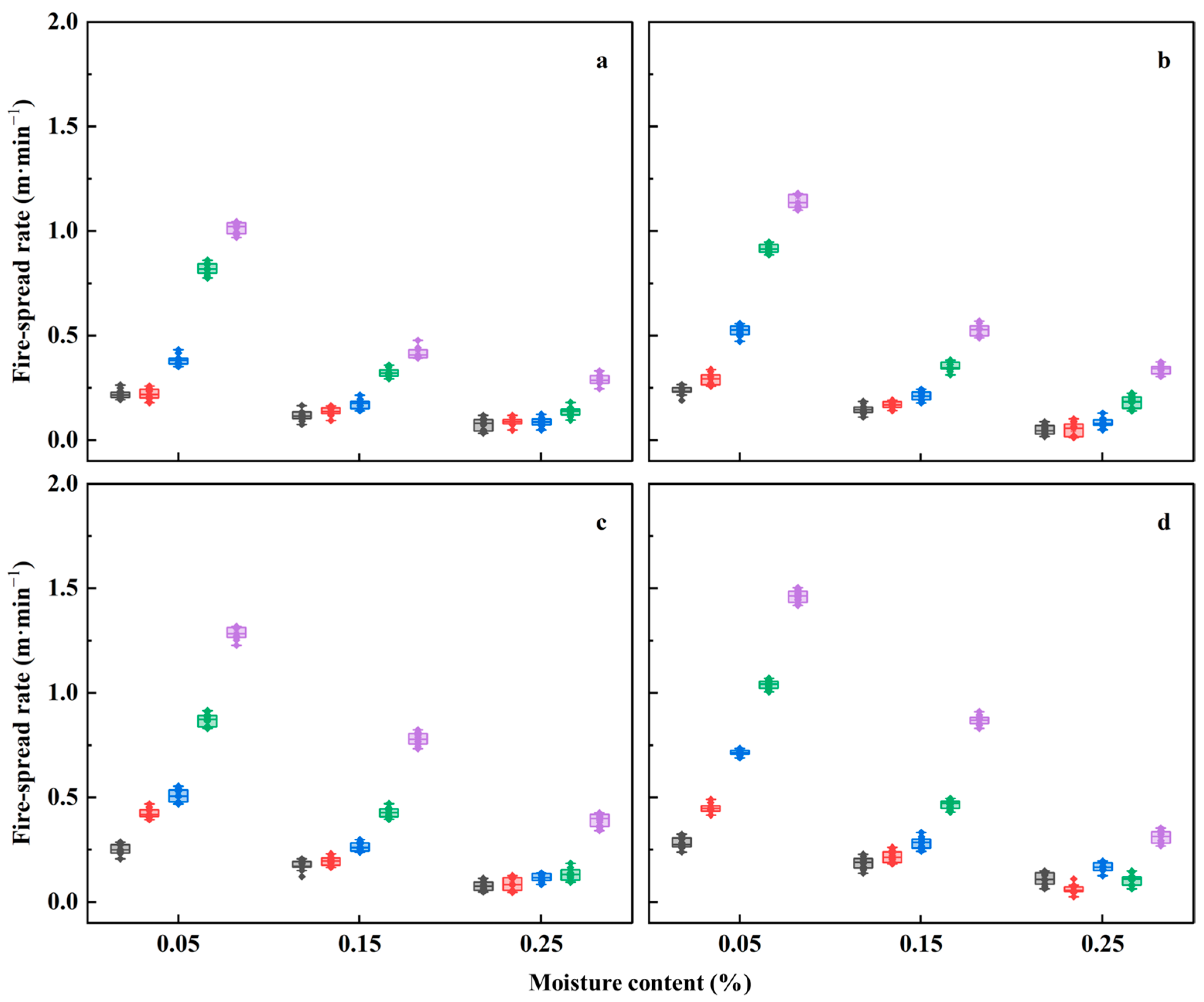
References
- Food and Agriculture Organization of the United Nations. The State of the World’s Forests 2022: Forest Pathways for Green Recovery and Building Inclusive, Resilient, and Sustainable Economies; FAO: Rome, Italy, 2022. [Google Scholar]
- Ju, L. Study on Combustibility of Several Main Tree Species in Heilongjiang Provience. Master’s Thesis, Northeast Forestry University, Heilongjiang, China, 2009. [Google Scholar]
- Zhang, S. Study on Forest Furface Fuel in Wan Dian Zi Experimental Forest Farm of Liaoning. Master’s Thesis, Shenyang Agricultural University, Shenyang, China, 2018. [Google Scholar]
- Ning, J.B.; Yang, G.; Liu, X.Y.; Geng, D.T.; Wang, L.X.; Li, Z.G.; Zhang, Y.L.; Di, X.Y.; Sun, L.; Yu, H.Z. Effect of fire spread, flame characteristic, fire intensity on particulate matter 2.5 released from surface fuel combustion of Pinus koraiensis plantation—A laboratory simulation study. Environ. Int. 2022, 166, 107352. [Google Scholar] [CrossRef]
- Jin, S.; Chu, T.F.; Di, X.Y.; Liu, B.F.; Zhang, J.L. Influence Factors on Fire Spread Across Fuel Beds of Korean Pine Needles Under No-wind and Zero-slope Conditions and Modeling of Fire Behavior. J. Northeast For. Univ. 2012, 40, 51–57. [Google Scholar]
- Geng, D.T.; Ning, J.B.; Li, Z.G.; Yu, H.Z.; Di, X.Y.; Yang, G. Spread rate and parameter modification of surface fuel in Pinus koraiensis plantation based on Rothermel model. J. Beijing For. Univ. 2021, 43, 79–88. [Google Scholar]
- Wang, M.Y.; Li, T.; Ren, Y.M.; Shu, L.F.; Zhao, F.J.; Tian, X.R. Research Advances in Forest Fire Behavior and Special Forest Fire Behaviors. World For. Res. 2009, 22, 45–49. [Google Scholar]
- McArthur, A.G. Control Burning in Eucalypt Forests. Leaflet No.80. In Proceedings of the Eighth British Commonwealth Forestry Conference, Nairobi, Kenya, 25 June–28 July 1962. [Google Scholar]
- Zhong, Z.R.; Zhou, J.J.; Zou, Y.H.; Zhu, J.P. Study on the Model of Wildland Fire Spread. Fire Saf. Sci. 2001, 10, 83–87. [Google Scholar]
- Gao, Z.L.; Shu, L.F.; Wang, M.Y.; Zhao, F.J.; Zhou, Y.L. Model for predicting the forest fire preading speed based on the prescriptive combustion of Pinus yunnanensis. J. Saf. Environ. 2016, 16, 82–86. [Google Scholar]
- Sullivan, A.L. Wildland surface fire spread modelling, 1990–2007. 2: Empirical and quasi-empirical models. Int. J. Wildland Fire 2009, 18, 369–386. [Google Scholar] [CrossRef]
- Sullivan, A.L. Wildland surface fire spread modelling, 1990–2007. 1: Physical and quasi-physical models. Int. J. Wildland Fire 2009, 18, 349–368. [Google Scholar] [CrossRef]
- Sullivan, A.L. Wildland surface fire spread modelling, 1990–2007. 3: Simulation and mathematical analogue models. Int. J. Wildland Fire 2009, 18, 387–403. [Google Scholar] [CrossRef]
- Rothermel, R.C. A Mathematical Model for Predicting Fire Spread in Wildland Fuels; Research Paper INT-115; USDA Forest Service, Intermountain Forest and Range Experiment Station: Ogden, UT, USA, 1972. [Google Scholar]
- Frandsen, W.H. Fire spread through porous fuels from the conservation of energy. Combust. Flame 1971, 16, 9–16. [Google Scholar] [CrossRef]
- Finney, M.A. An Overview of FlamMap Fire Modeling Capabilities. In Proceedings of the 1st Fire Behavior and Fuels Conference, Portland, OR, USA, 28–30 May 2006. [Google Scholar]
- Finney, M.A. FARSITE: Fire Area Simulator-Model Development and Evaluation; Research Paper RMRS-RP-4; USDA Forest Service, Rocky Mountain Research Station: Missoula, MT, USA, 1998. [Google Scholar]
- Andrews, P.L. BEHAVE: Fire Behavior Prediction and Fuel Modeling System-BURN Subsystem, Part 1; Research Paper INT-194; USDA Forest Service, Intermountain Forest and Range Experiment Station: Ogden, UT, USA, 1986. [Google Scholar]
- Andrews, P.L.; Bevins, C.D.; Seli, R.C. BehavePlus Fire Modeling System Version 4.0 User’s Guide; General Technical Report RMRS-GTR-106WWW; USDA Forest Service, Rocky Mountain Research Station: Ogden, UT, USA, 2008. [Google Scholar]
- Man, Z.Y.; Sun, L.; Hu, H.H.; Zhang, Y.L. Prediction Model of the Spread Rate of Eight typical Surface Dead Fuel in Southern China under Windless and Flat Land. Sci. Silvae Sin. 2019, 55, 197–204. [Google Scholar]
- Jimenez, E.; Hussaini, M.Y.; Goodrick, S. Quantifying parametric uncertainty in the Rothermel model. Int. J. Wildland Fire 2008, 17, 638–649. [Google Scholar] [CrossRef]
- Hua, J.; Zhang, S.Y.; Gao, H.W.; Chen, X.D. Optimizing the Rothermel Model for easily predicting spread rate of forest fire. Math. Comput. For. Nat. Resour. Sci. 2020, 12, 62–71. [Google Scholar]
- Ren, M.L.; Guo, Y.; Chen, B.X.; Fan, J.L.; Hu, T.X.; Sun, L. Prediction models of fire spread rate of Pinus koraiensis plantation’s surface fuel. Chin. J. Appl. Ecol. 2023, 34, 2091–2100. [Google Scholar]
- Masinda, M.M.; Li, F.; Liu, Q.; Sun, L.; Hu, T. Prediction model of moisture content of dead fine fuel in forest plantations on Maoer Mountain, Northeast China. J. For. Res. 2021, 32, 2023–2035. [Google Scholar] [CrossRef]
- Li, Z.Y. The Environmental Influence Because of Japanese and Russian Occupation of the Northeast Since Modern Times —Focusing on the Investigation of Forest Resources. Acad. J. Jinyang. 2019, 3, 14–22. [Google Scholar]
- Zhao, F.J.; Liu, Y.Q.; Shu, L.F. Change in the fire season pattern from bimodal to unimodal under climate change: The case of Daxing’aning in Northeast China. Agric. For. Meteorol. 2020, 291, 108075. [Google Scholar] [CrossRef]
- Wang, W.F.; Song, L.N.; Sui, X. Estimation of Forest Biomass and lts Temporal and Spatial Distribution Patterns in Maoershan Forest Farm, Heilongjiang Province. J. Northeast For. Univ. 2010, 38, 47–49. [Google Scholar]
- Li, H. Effects of Fuel Bed Width on Upslope Fire Spread: Experimental and Theoretical Study. Ph.D. Thesis, University of Science and Technology of China, Hefei, China, 2020. [Google Scholar]
- Jin, S.; Liu, B.F.; Di, X.Y.; Chu, T.F.; Zhang, J.L. Fire behavior of Mongolian Oak leaves fuel-bed under no-wind and zero-slope conditions. I. Factors affecting fire spread rate and modeling. Chin. J. Appl. Ecol. 2012, 23, 51–59. [Google Scholar]
- Awad, C.; Morvan, D.; Rossi, J.; Marcelli, T.; Chatelon, F.J.; Morandini, F.; Balbi, J. Fuel moisture content threshold leading to fire extinction under marginal conditions. Fire Saf. J. 2020, 118, 103226. [Google Scholar] [CrossRef]
- Weise, D.R.; Koo, E.; Zhou, X.; Mahalingam, S.; Morandini, F.; Balbi, J.-H. Fire spread in chaparral—A comparison of laboratory data and model predictions in burning live fuels. Int. J. Wildland Fire 2016, 25, 980–994. [Google Scholar] [CrossRef]
- Campbell-Lochrie, Z.; Walker-Ravena, C.; Gallagher, M.; Skowronski, N.; Mueller, E.V.; Hadden, R.M. Effects of fuel bed structure on heat transfer mechanisms within and above porous fuel beds in quiescent flame spread scenarios. Int. J. Wildland Fire. 2023, 32, 913–926. [Google Scholar] [CrossRef]
- Zhang, Y.C.; Kong, L.Y.; Guo, H.W.; Gao, Y.J. Experimental study on the effects of fuel load and water content on surface fire spread over flat fuel bed. Fire Sci. Technol. 2022, 41, 261–265. [Google Scholar]
- Frandsen, W.H.; Rothermel, R.C. Measuring the energy-release rate of a spreading fire. Combust. Flame 1972, 19, 17–24. [Google Scholar] [CrossRef]
- Anderson, H.E. Heat Transfer and Fire Spread; Research Paper INT-69; USDA Forest Service, Intermountain Forest and Range Experiment Station: Ogden, UT, USA, 1969. [Google Scholar]
- Frandsen, W.H. Effective Heating of Fuel Ahead of Spreading Fire; Research Paper INT-140; USDA Forest Service, Intermountain Forest and Range Experiment Station: Ogden, UT, USA, 1973. [Google Scholar]
- Pan, D.; Zhang, H.P.; Pan, G.; Yi, L. Research on masson pine potential fire behavior in southern subtropical based on Behave Plus. J. Cent. South Univ. For. Technol. 2017, 37, 14–23. [Google Scholar]
- Zhang, Y.L.; Tian, L.L. Examining and Reforming the Rothermel Surface Fire Spread Model under No-Wind and Zero-Slope Conditions for the Karst Ecosystems. Forests 2023, 14, 1088. [Google Scholar] [CrossRef]
- Campbell-Lochrie, Z.; Gallagher, M.; Skowronski, N.; Hadden, R.M. The effect of fuel bed structure on Rothermel model performance. Int. J. Wildland Fire 2023, 33, WF23046. [Google Scholar] [CrossRef]
- Zhang, J.L.; Liu, B.F.; Chu, T.F.; Di, X.Y.; Jin, S. Fire behavior of ground surface fuels in Pinus koraiensis and Quercus mongolica mixed forest under no wind and zero slope condition: A prediction with extended Rothermel model. Chin. J. Appl. Ecol. 2012, 23, 1495–1502. [Google Scholar]
- Li, C.Y.; Jin, S.; Zhou, Y.; Zhang, J.L. A Simulation on Wind Factors of Fuelbed of Korean Pine Needles. Sci. Silvae Sin. 2014, 50, 116–124. [Google Scholar]
- Maffei, C.; Menenti, M. Predicting forest fires burned area and rate of spread from pre-fire multispectral satellite measurements. ISPRS J. Photogramm. Remote Sens. 2019, 158, 263–278. [Google Scholar]
- Masinda, M.M.; Sun, L.; Wang, G.Y.; Hu, T.X. Moisture content thresholds for ignition and rate of fire spread for various dead fuels in northeast forest ecosystems of China. J. For. Res. 2021, 32, 1147–1155. [Google Scholar] [CrossRef]
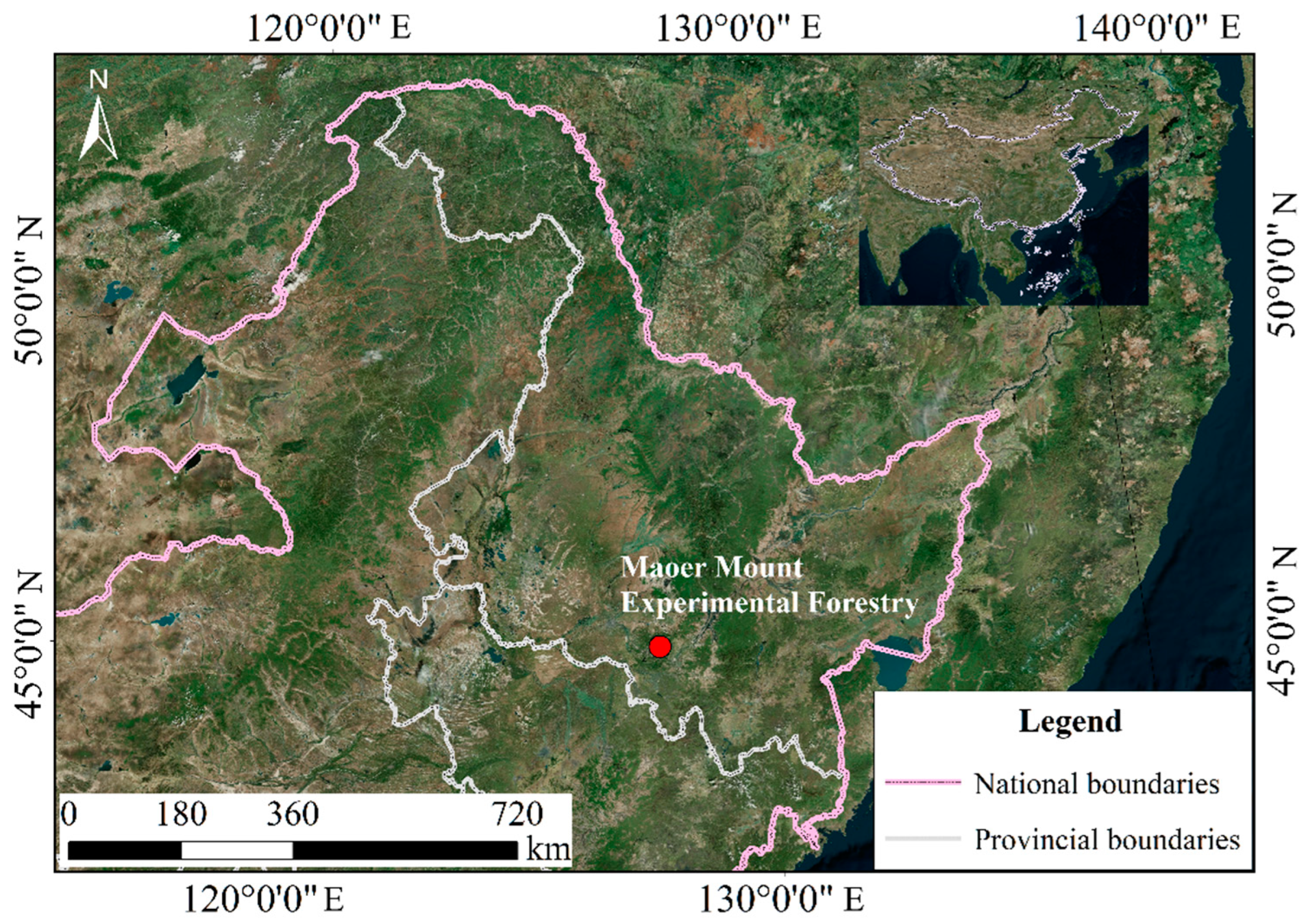
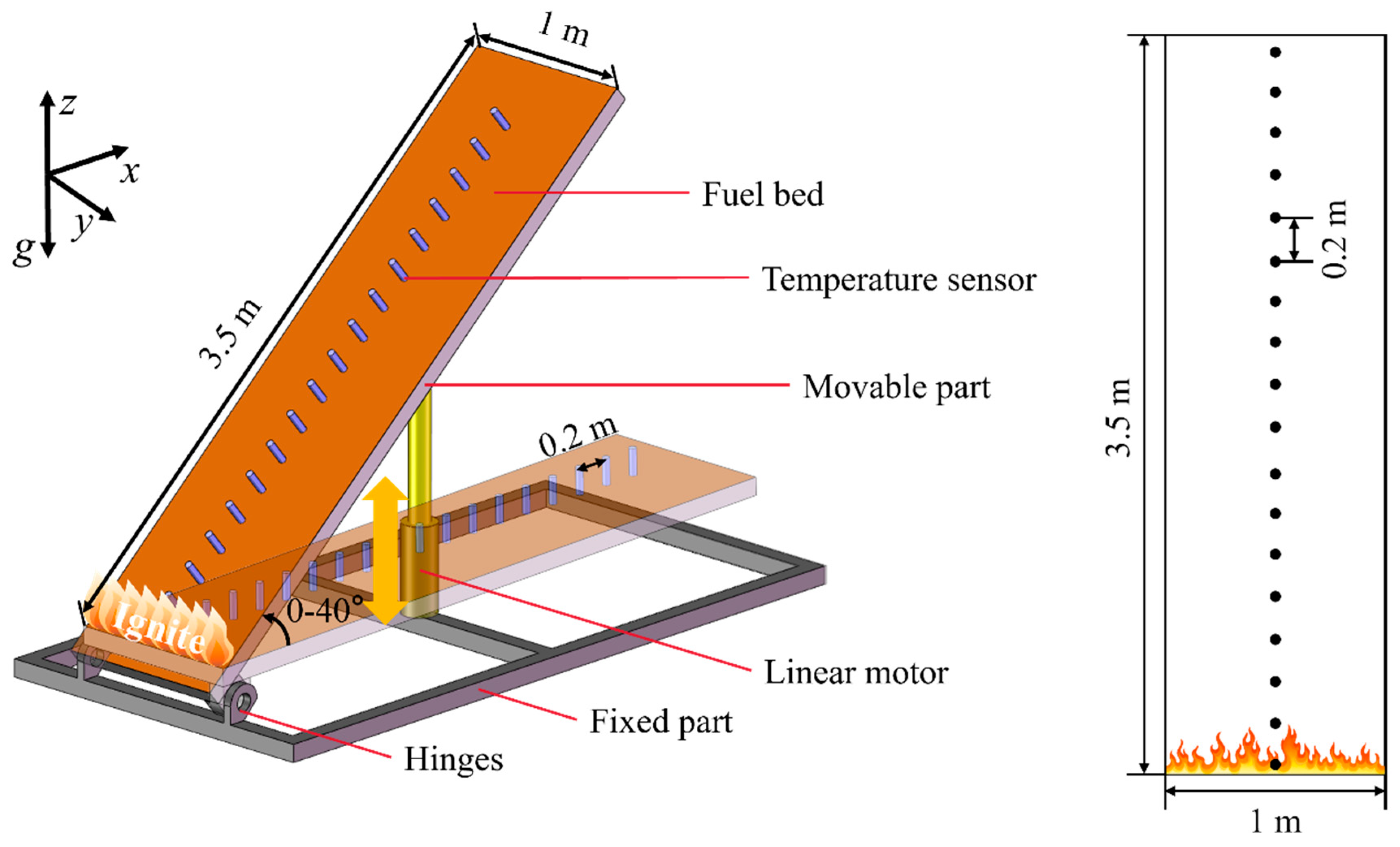


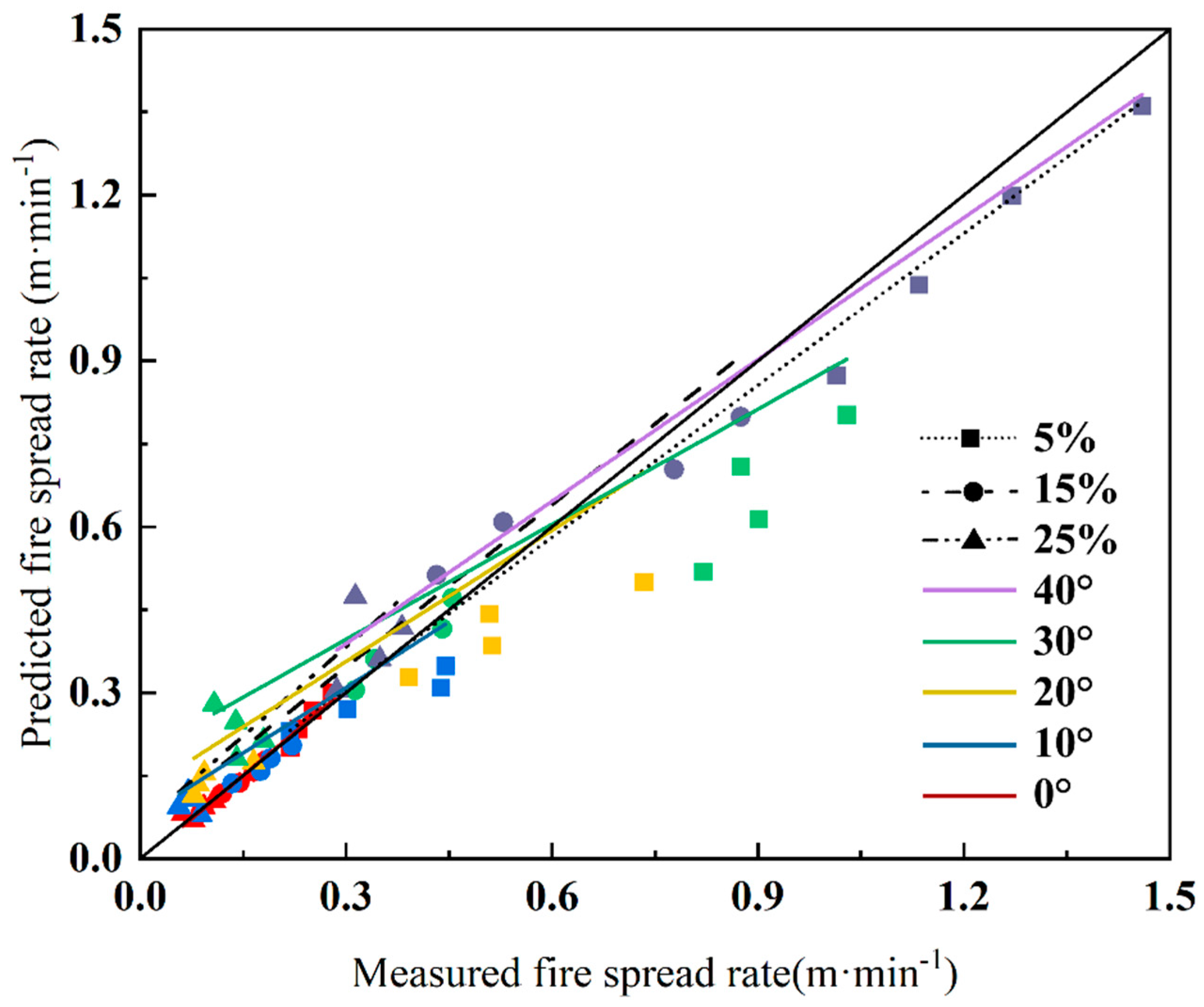

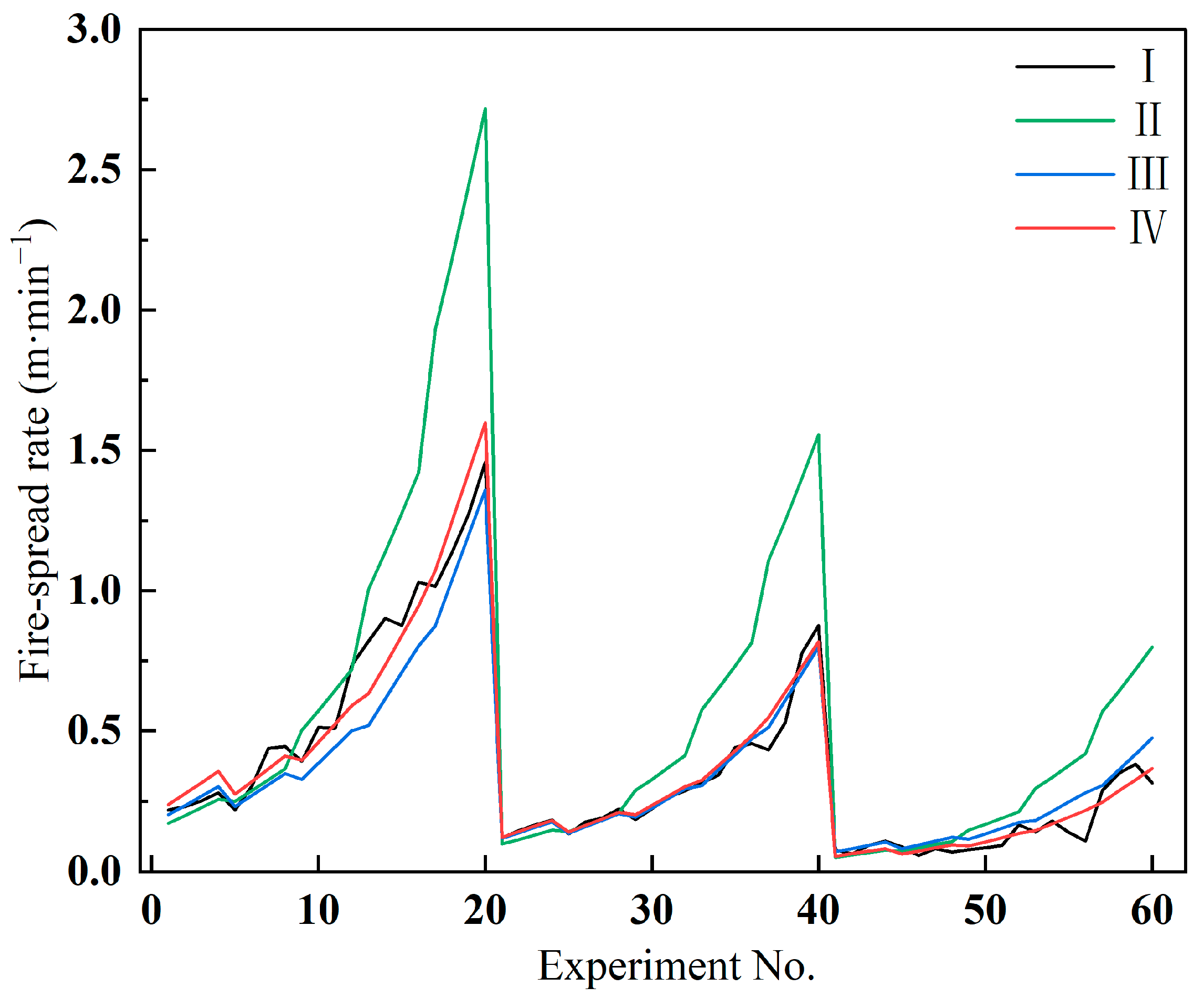
| No. | Mean Height (m) | Mean Diameter (cm) | Canopy Density | Moisture Content (%) | Load (kg·m−2) | Slope (°) |
|---|---|---|---|---|---|---|
| 1 | 15.6 ± 1.3 | 21.6 ± 3.2 | 0.7 | 13.7 ± 0.5 | 0.6 ± 0.1 | 13 ± 2 |
| 2 | 19.4 ± 2.3 | 26.5 ± 2.4 | 0.8 | 18.6 ± 0.8 | 0.9 ± 0.1 | 26 ± 1 |
| 3 | 23.5 ± 1.7 | 22.3 ± 3.7 | 0.9 | 21.1 ± 0.6 | 1.0 ± 0.1 | 33 ± 1 |
| Fuel Type | Moisture Content (%) | Load (kg·m−2) | Slope (°) |
|---|---|---|---|
| Pinus koraiensis | 5 15 25 | 0.5 0.7 0.9 1.1 | 0 |
| 10 | |||
| 20 | |||
| 30 | |||
| 40 |
| Symbolic | Name of Inputs | Unit | Inputs Value |
|---|---|---|---|
| Fuel particle moisture content | - | Experiment | |
| Moisture content of extinction | - | 0.3 [14] | |
| Ovendry fuel load | lb·ft−2 | Experiment | |
| Fuel particle total mineral content | - | 0.0555 [14] | |
| Fuel particle effective mineral content | - | 0.01 [14] | |
| Ovendry particle density | lb·ft−3 | 23.4 [23] | |
| Fuel particle surface-area-to-volume ratio | ft−1 | 3325 [23] | |
| Fuel depth | ft | Experiment | |
| Fuel particle low heat content | Btu·lb−1 | 5368.78 [23] | |
| φ | Slope | ° | Experiment |
| Source of Variation | df | Mean Square | F-Value | p-Value |
|---|---|---|---|---|
| Slope | 4 | 0.669 | 196.088 | 0.000 ** |
| Moisture content | 2 | 1.310 | 384.192 | 0.000 ** |
| Load | 3 | 0.056 | 16.337 | 0.000 ** |
| Slope × Moisture content | 8 | 0.102 | 29.791 | 0.000 ** |
| Slope × Load | 12 | 0.007 | 2.184 | 0.050 * |
| Moisture content × Load | 6 | 0.011 | 3.148 | 0.020 * |
| Slope (°) | Average Absolute Error (MAE) (m·min−1) | Mean Relative Error (MRE) (%) | Root-Mean-Square Error (RMSE) (m·min−1) | Regression Coefficient | R2 |
|---|---|---|---|---|---|
| 0 | 0.028 | 17.625 | 0.030 | 0.944 | 0.977 |
| 10 | 0.031 | 15.335 | 0.044 | 0.711 | 0.943 |
| 20 | 0.088 | 29.913 | 0.094 | 0.926 | 0.957 |
| 30 | 0.274 | 57.284 | 0.286 | 1.110 | 0.956 |
| 40 | 0.707 | 96.188 | 0.782 | 1.735 | 0.940 |
| Moisture Content (%) | Average Absolute Error (MAE) (m·min−1) | Mean Relative Error (MRE) (%) | Root-Mean-Square Error (RMSE) (m·min−1) | Regression Coefficient | R2 |
|---|---|---|---|---|---|
| 5 | 0.315 | 48.261 | 0.273 | 2.008 | 0.917 |
| 15 | 0.226 | 69.944 | 0.113 | 2.143 | 0.929 |
| 25 | 0.137 | 92.636 | 0.037 | 2.185 | 0.854 |
| Slope (°) | Average Absolute Error (MAE) (m·min−1) | Mean Relative Error (MRE) (%) | Root-Mean-Square Error (RMSE) (m·min−1) | Regression Coefficient | R2 |
|---|---|---|---|---|---|
| 0 | 0.010 | 5.961 | 0.012 | 1.039 | 0.972 |
| 10 | 0.037 | 18.179 | 0.052 | 0.788 | 0.946 |
| 20 | 0.056 | 18.907 | 0.085 | 0.788 | 0.966 |
| 30 | 0.117 | 24.433 | 0.157 | 0.694 | 0.929 |
| 40 | 0.080 | 10.758 | 0.090 | 0.855 | 0.975 |
| Moisture Content (%) | Average Absolute Error (MAE) (m·min−1) | Mean Relative Error (MRE) (%) | Root-Mean-Square Error (RMSE) (m·min−1) | Regression Coefficient | R2 |
|---|---|---|---|---|---|
| 5 | 0.111 | 16.982 | 0.020 | 0.916 | 0.975 |
| 15 | 0.023 | 7.242 | 0.001 | 0.977 | 0.936 |
| 25 | 0.045 | 30.245 | 0.004 | 1.077 | 0.746 |
| Slope (°) | Average Absolute Error (MAE) (m·min−1) | Mean Relative Error (MRE) (%) | Root-Mean-Square Error (RMSE) (m·min−1) | Regression Coefficient | R2 |
|---|---|---|---|---|---|
| 0 | 0.024 | 14.890 | 0.035 | 1.418 | 0.973 |
| 10 | 0.024 | 11.691 | 0.031 | 0.866 | 0.943 |
| 20 | 0.030 | 10.066 | 0.047 | 0.820 | 0.962 |
| 30 | 0.061 | 12.793 | 0.086 | 0.795 | 0.960 |
| 40 | 0.083 | 11.349 | 0.091 | 1.115 | 0.973 |
| Moisture Content (%) | Average Absolute Error (MAE) (m·min−1) | Mean Relative Error (MRE) (%) | Root-Mean-Square Error (RMSE) (m·min−1) | Regression Coefficient | R2 |
|---|---|---|---|---|---|
| 5 | 0.077 | 11.783 | 0.009 | 1.025 | 0.942 |
| 15 | 0.025 | 7.850 | 0.002 | 0.980 | 0.960 |
| 25 | 0.031 | 20.959 | 0.002 | 0.847 | 0.829 |
| Models | Average Absolute Error (MAE) (m·min−1) | Mean Relative Error (MRE) (%) | Root-Mean-Square Error (RMSE) (m·min−1) | Regression Coefficient | R2 |
|---|---|---|---|---|---|
| Rothermel model | 0.226 | 60.337 | 0.375 | 1.742 | 0.895 |
| No-wind or slope condition priority modified Rothermel model | 0.060 | 15.925 | 0.093 | 0.815 | 0.942 |
| Slope condition priority modified Rothermel model | 0.044 | 11.749 | 0.063 | 0.999 | 0.964 |
Disclaimer/Publisher’s Note: The statements, opinions and data contained in all publications are solely those of the individual author(s) and contributor(s) and not of MDPI and/or the editor(s). MDPI and/or the editor(s) disclaim responsibility for any injury to people or property resulting from any ideas, methods, instructions or products referred to in the content. |
© 2024 by the authors. Licensee MDPI, Basel, Switzerland. This article is an open access article distributed under the terms and conditions of the Creative Commons Attribution (CC BY) license (https://creativecommons.org/licenses/by/4.0/).
Share and Cite
Guo, Y.; Hu, H.; Hu, T.; Ren, M.; Chen, B.; Fan, J.; Man, Z.; Sun, L. Applying and Evaluating the Modified Method of the Rothermel Model under No-Wind Conditions for Pinus koraiensis Plantations. Forests 2024, 15, 1178. https://doi.org/10.3390/f15071178
Guo Y, Hu H, Hu T, Ren M, Chen B, Fan J, Man Z, Sun L. Applying and Evaluating the Modified Method of the Rothermel Model under No-Wind Conditions for Pinus koraiensis Plantations. Forests. 2024; 15(7):1178. https://doi.org/10.3390/f15071178
Chicago/Turabian StyleGuo, Yan, Haiqing Hu, Tongxin Hu, Menglin Ren, Boxuan Chen, Jiale Fan, Ziyuan Man, and Long Sun. 2024. "Applying and Evaluating the Modified Method of the Rothermel Model under No-Wind Conditions for Pinus koraiensis Plantations" Forests 15, no. 7: 1178. https://doi.org/10.3390/f15071178





